[Click on BLUE links for sources and information]
Reminiscence and anecdote, as they tell of one’s meetings with the great or the prominent, are an established form of self-enhancement. They make known that one was there. This is not my purpose; my aim is to inform and perhaps, on occasion, to entertain. The risk, nonetheless, exists that critics who are less than tolerant may suggest that I am indulging in name-dropping. Hence the title of the book and that of this chapter; nothing so disarms a prosecutor as a prior confession of guilt.
John Kenneth Galbraith, Name Dropping
Name Dropping can be really irritating, especially the insincere and ineffective use of your name by a someone you hardly know (or don’t know) to show he’s your best friend. Here is a typical exchange between a “name-dropper” and a server.
“What’s your name?”
“Tanya.”
“Tanya? How are you doing, Tanya?”
“Great, how can I help you?”
“Well, how’s it going for you today, Tanya?”
If you find this false display of interest off putting by someone who doesn’t know you and probably could care less, read the hilarious takedown by Monya De in Stanford Magazine. You will never think of using a stranger’s first name in such a familiar way again.
I’m all for building customer relationships, but a company would achieve that through taking a genuine interest in a customer’s happiness, not by parroting his or her name like some kind of Pavlovian trigger word. The owners of the toothy grins? I doubt they’d remember my moniker if they saw me on the street. Monya De
Social media platforms such as Facebook use this technique all the time to appeal to your emotions. So do advertisers, groups and politicians seeking donations. For what it’s worth, I immediately trash any solicitation that has my first name in it unless it’s from a local organization I actually care about.
Another form of name dropping is to pump yourself up by using the names of famous people even though you may know them only casually if at all. Does it work? Certainly not for me but maybe for some. Name dropping is a sort of “argumentum ad verecundiam” (argument from authority), something astrophysicist Carl Sagan warned against in his “baloney detection kit.”
John Kenneth Galbraith worried enough about being classified as a name-dropper that he prefaced his book with the quote above. His defense was that he actually knew the people he wrote about and felt he had something interesting and new to offer. This may work for him but it doesn’t always work so well for the rest of us.
I always enjoy reading Galbraith even if he is pompous at times. I especially like The Affluent Society which remains fresh and relevant even today. I didn’t know him personally. Had I met him, he at 6’ 8”, I at 5’7”, it would have been difficult to see eye to eye. You might like the debate between W. F. Buckley (uber-conservative) and J. K. Galbraith (uber-liberal) held at a time when civilized debate was encouraged and expected of serious thinkers even when full of themselves. Unfortunately that political atmosphere was jettisoned with the far left and the coffin nailed tight with the Tea Party. Civilized debate is now considered “elitist” and boring. Politics today is all about clicks. And clicks are what name-droppers are looking for. If you are so inclined, we offer this gem of a discussion so out of touch with the current atmosphere that it can be considered a quaint oddity of times past.
Galbraith’s book, Name Dropping, is a short personal history of the famous people he knew well or worked with. He chose his cast of characters with two specific criteria.
There will be question less as to those who have been selected for recollection and celebration here than as to those omitted or discussed only briefly. The reason is not far to seek; it is whether or not I was there and have something to add. J. K. Galbraith, Name Dropping
The book is a short, chatty, witty history of Galbraith’s interactions with leaders and their cohorts from FDR to Reagan. While reading the book, it occurred to me how the napkin artists at the Sea Gull Cellar Bar captured many of the events Galbraith writes about.
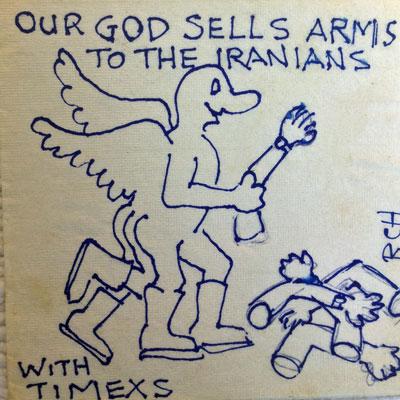
Sea Gull Cellar Bar Napkin Art, Roy Hoggard artist
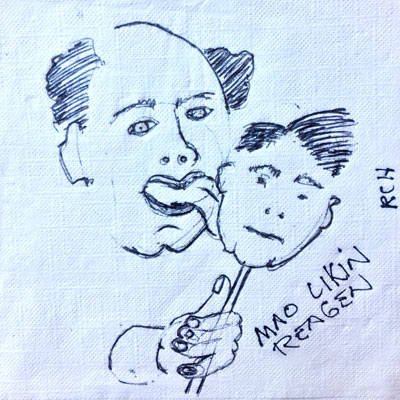
Sea Gull Cellar Bar Napkin Art, Roy Hoggard artist
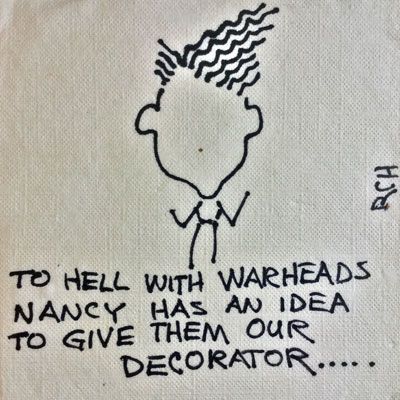
Sea Gull Cellar Bar Napkin Art, Roy Hoggard artist
Restaurants and bars like to display signed pictures from their famous patrons. Old timers may remember Mitch’s Barber Shop in Mendocino where photographs (not just of the rich and famous but mostly of Mendocino locals and characters) graced the walls. This kind of name-dropping actually appeals to me.
Second and third degree name dropping (I knew Joe who knew Ted) is for the most desperate of status seekers. For those who simply can’t avoid showing off this way, for God’s sake at least get the pronunciation correct (see An Incomplete Guide to Proper Name Dropping).
And, you better be prepared to back up any claims you make. Name dropping comes with risks as Dan Quayle found out to his eternal dismay in his debate with Lloyd Benson.
Even our great communicator President Ronald Reagan was known for his gaffes including inappropriate name dropping (rather like the Joe Biden of today) although this did not impair his electability.
Name dropping can effectively be “used in works of fiction to place a story in a certain historical timeframe’ or to imply the involvement of a historical figure in the action.” A great example where this technique is used extensively is in The Hundred-Year-Old Man Who Climbed Out The Window And Disappeared by Jonas Jonasson. TITM discussed this book briefly in Serendipity. This is another type of name dropping I find acceptable.
Naive name dropping is mostly counter productive. It may work to establish trust when discussing joint friends but when employed to impress, to elicit the “wow” factor or “jaw dropping” credibility, its usefulness in questionable at best.
Use name-dropping sparingly as you want to be known for your contributions rather than your connections. Jeffrey Kudisch
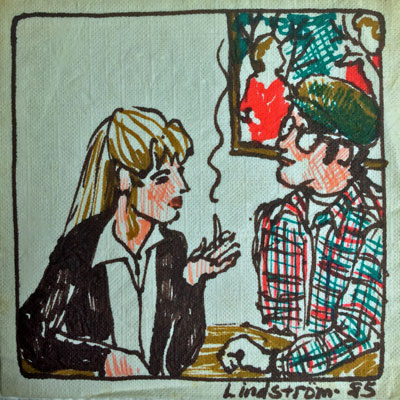
Sea Gull Cellar Bar Napkin Art, Sandra Lindstrom artist

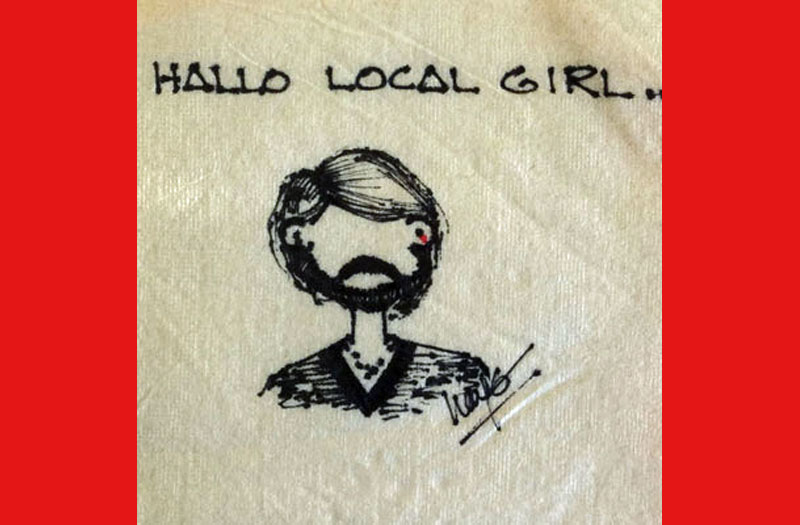
Galbraith pompous? Just a teensy little taste of Buckley–literally all I could stomach–reminds us of the true meaning of the word…
Ha. Yes, Galbraith is pompous. Buckley is an ass. His son Christopher is working hard to atone.
Yes. And doing a great job of it. Ron Reagan Jr. doing similar reparations.